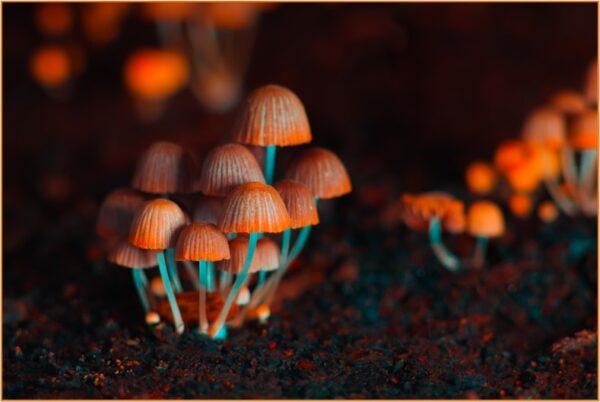
Recently, psychedelic drugs such as LSD and ketamine have gained a great deal of attention among scientists, doctors, and the public. Many of these drugs –including LSD, MDMA (ecstasy), and psilocybin (the active compound in “magic mushrooms”)– have been illegal since the late 1960s, with very limited exceptions for research (Public Law No. 90-639, 1968). Others (like ketamine) are legal, but highly restricted (Marshall, 1999). Nevertheless, research beginning in the early 2000s has revealed that psychedelics can improve symptoms for patients suffering from mental illnesses such as depression, anxiety, and Post Traumatic Stress Disorder (Yaden et al., 2022). In contrast to other treatments, psychedelics stand out in their ability to create, for example, feelings of “substantial personal meaning and spiritual significance” (Griffiths et al., 2006). Because of this, some federal regulations, which currently classify most psychedelics as having “no currently accepted medical use,” have been relaxed in order to allow for an increase in the number of clinical trials and research studies investigating psychedelics’ effects on humans (Drug Enforcement Agency, 2018).
The transformation in our understanding of psychedelics, from recreational “party drugs” to unique and potentially transformative agents, has made this subject particularly appealing to science journalists. In science communication, it is often necessary to simplify the results of experiments in order to effectively communicate them to a lay audience. However, in cases like this where science intersects with medicine, simplification becomes a particularly risky business because communicators may focus on what is exciting for their audience, without appropriately explaining the limitations.
Though it is often done to improve communication, simplifying the results of scientific and clinical studies can lead people to make premature conclusions about the benefits of the treatment that was studied. When it comes to psychedelics, headlines such as “Psychedelics Like MDMA Could Revolutionize Couples Therapy” (Ducharme, 2023) and “Psychedelic Use Could Lower Suicide Risk” (Oberhaus, 2017) tout all of the potential benefits of psychedelic drugs without describing the risks—or mentioning that these risks are still not fully known. This positive media attention may encourage dangerous behavior. When communicators fail to explain the high level of control in most research studies, it can appear that it is advisable to personally use a psychedelic drug to manage one’s mental health. While some research suggests that personal use of psychedelics can be helpful for some people, attempting to self-medicate is far more dangerous than the administration of drugs under medical supervision. For example, someone with a family history of schizophrenia who does not (yet) have a schizophrenia diagnosis may be triggered into a psychotic break during a psychedelic “trip,” but this is rarely discussed when psychedelics are hyped in news articles (Roth & McClure-Begley, 2022).
According to some of the leading psychedelic researchers in the United States, psychedelic research has become “trapped in a hype bubble driven largely by media and industry interests” (Yaden et al., 2022). This hype bubble is characterized by “highly inflated expectations” and “overly positive press reports” of psychedelics, but once expectations are not met, public perception of psychedelics may quickly decline into the “trough of disillusionment” (Yaden et al., 2022). Because the risks of psychedelics are not fully known, some patients determined to be appropriate for psychedelic therapy may nevertheless be harmed. However, because psychedelics are so hyped and widely visible, “such cases will be widely reported, often without the context of how clinical trials contribute to scientific progress” (Yaden et al., 2022). Such reports can erode public trust in science and medicine.
Alternatively, the current media attention on psychedelics can counter negative ideas and stigma about these drugs. Research of psychedelics’ effects in humans has found that psychedelics do not, in fact, cause “a psychotic-like state of delirium,” rather, they can cause meaningful, even spiritual, states of mind (Yaden et al., 2022). Indeed, psychedelics have been used by various indigenous peoples throughout the Americas for centuries to engage with spiritual, ancestral, and other non-human planes of existence (Fotiou, 2019 and Williams et al., 2022). Michael Pollan, a journalist who has focused his career on psychedelics, believes “these drugs could help people in profound ways—and possibly even help society in profound ways” (Hicks, 2018). Pollan, like other pro-psychedelic public figures, hopes to share his enthusiasm for psychedelics because of his belief that doing so will have a widespread, positive impact on the world.
Informing the public of the positive effects of psychedelics is difficult to do without simplification, but sharing these positive effects may be especially important when it comes to ensuring people with mental illness are considering all treatment options. When it comes to patients, the current hype may help psychedelics seem less intimidating. If a patient believes, for example, that psychedelics are addictive (they are not) or are physically harmful (“magic mushrooms” were found to be the least dangerous of all drugs), they might not want to consider psychedelic therapy as an option (Schlag et al., 2022). The current positive bias towards psychedelics in the media could help to counter misinformation regarding psychedelics, leading to a more informed patient population.
The fascinating development of psychedelic research has the spotlight, not only in scientific and medical communities, but among the public as well. With this attention comes the potential for increased enthusiasm for science during a time when Americans’ trust in scientists is on the decline (Kennedy et al., 2022). However, overly optimistic expectations may make for an even harder “fall” when psychedelics inevitably do not meet all of these expectations. Scientists, journalists, and other science communicators are all approaching this topic from different backgrounds, so of course, their communication will be different. Nevertheless, all groups may have a responsibility to balance the good with the bad, raising the question: what is the best way to communicate about psychedelic science in the midst of current media hype?
Discussion Questions:
- Do journalists writing about psychedelics have an ethical obligation to discuss the risks and downsides of psychedelics?
- Is there a way to balance excitement and objectivity when reporting on psychedelics? How much simplification is allowed in scientists communicating their findings with the public?
- What are some guidelines or principles that scientists and medical researchers studying psychedelics should follow in communicating their work with the public? What values ground these suggested moral rules?
- Does the public have any responsibility in responding to the media hype around psychedelics? How should the public engage such research?
Further Information:
Drug Enforcement Agency. (2018, January 18). “DEA Speeds Up Application Process for Research on Schedule I Drugs.” dea.gov. Available at: https://www.dea.gov/press-releases/2018/01/18/dea-speeds-application-process-research-schedule-i-drugs
Ducharme, Jamie. (2023, March 14). “Psychedelics Could Revolutionize Couples Therapy.” TIME. Available at: https://time.com/6262291/psychedelics-mdma-couples-therapy/
Fotiou, Evgenia. (2020, March 1). “The role of Indigenous knowledges in psychedelic science.” Journal of Psychedelic Studies (4)1. Available at: https://akjournals.com/view/journals/2054/4/1/article-p16.xml
Griffiths, R. R., Richards, W. A., McCann, U., & Jesse, R. (2006, July 7). “Psilocybin can occasion mystical-type experiences having substantial and sustained personal meaning and spiritual significance.” Psychopharmacology 187: 268–283. Available at: https://link.springer.com/article/10.1007/s00213-006-0457-5
Hicks, Jesse. (2018, May 15). “Psilocybin Treatment for Major Depression Effective for Up to a Year for Most Patients, Study Shows.” VICE. Available at: https://www.vice.com/en/article/zm8v7x/michael-pollan-psychedelics-change-your-mind
Kennedy, Brian, Tyson, Alec, & Funk, Cary. (2022, February 15). “Americans’ Trust in Scientists, Other Groups Declines.” Pew Research Center. Available at: https://www.pewresearch.org/science/2022/02/15/americans-trust-in-scientists-other-groups-declines/
Martinez, Marisol. (2022, February 15). “Psilocybin Treatment for Major Depression Effective for Up to a Year for Most Patients, Study Shows.” Johns Hopkins Medicine Newsroom. Available at: https://www.hopkinsmedicine.org/news/newsroom/news-releases/psilocybin-treatment-for-major-depression-effective-for-up-to-a-year-for-most-patients-study-shows
Marshall, Donnie R. (1999, July 13). “Schedules of Controlled Substances: Placement of Ketamine into Schedule III.” Federal Register 64(133): 37673-37675. Available at: https://www.federalregister.gov/documents/1999/07/13/99-17803/schedules-of-controlled-substances-placement-of-ketamine-into-schedule-iii
Oberhaus, Daniel. (2017, May 1). “Psychedelic Use Could Lower Suicide Risk.” VICE. Available at: https://www.vice.com/en/article/kbm4nv/psychedelic-use-could-lower-suicide-risk
Public Law No. 90-639. (1968, October 24). “An Act to amend the Federal Food, Drug, and Cosmetic Act to prescribe penalties for the possession of LSD and other hallucinogenic drugs by unauthorized persons.” Library of Congress. Available at: https://www.congress.gov/bill/90th-congress/house-bill/14096/text
Roth, Bryan L., & McClure-Begley, Tristan D. (2022, March 17). “The promises and perils of psychedelic pharmacology for psychiatry.” Nature Reviews Drug Discovery 21: 463-473. Available at: https://doi.org/10.1038/s41573-022-00421-7
Schlag, Anne K., Aday, Jacob, Salam, Iram, Neill, Jo C., & Nutt, David J. (2022, February 2). “Adverse effects of psychedelics: From anecdotes and misinformation to systematic science.” Journal of Psychopharmacology 36(3). Available at: https://journals.sagepub.com/doi/10.1177/02698811211069100
Williams, Keith, Sinuhé González Romero, Osiris, Braunstein, Michelle, & Brant, Suzanne. (2022, July 30). “Indigenous Philosophies and the “Psychedelic Renaissance.’” Anthropology of Consciousness, 33(2): 506-527. Available at: https://anthrosource.onlinelibrary.wiley.com/doi/full/10.1111/anoc.12161
Yaden, David B., Potash, James B., & Griffiths, Roland, R. (2022, August, 31). “Preparing for the Bursting of the Psychedelic Hype Bubble.” JAMA Psychiatry 79(10): 943-944. Available at: https://jamanetwork.com/journals/jamapsychiatry/fullarticle/2795948
Authors:
Emma Babaian, Kat Williams, & Scott R. Stroud, Ph.D.
Media Ethics Initiative
Center for Media Engagement
University of Texas at Austin
July 18, 2023
Image by DmitrySteshenko on EnvatoElements
This case was supported by funding from the John S. and James L. Knight Foundation. It can be used in unmodified PDF form in classroom or educational settings. For use in publications such as textbooks, readers, and other works, please contact the Center for Media Engagement.
Ethics Case Study © 2023 by Center for Media Engagement is licensed under CC BY-NC-SA 4.0




